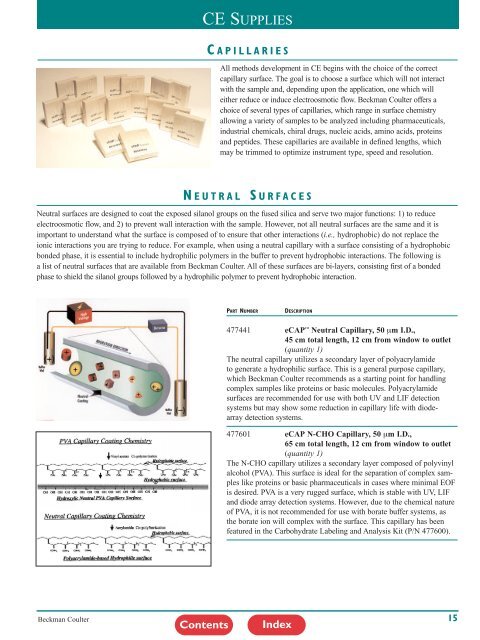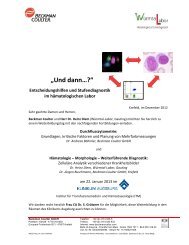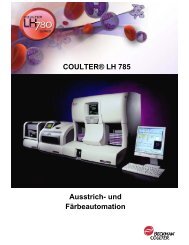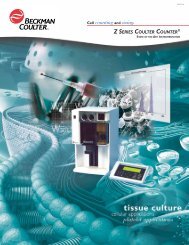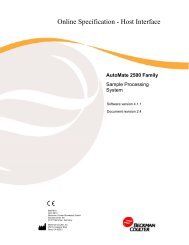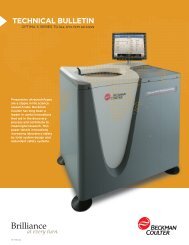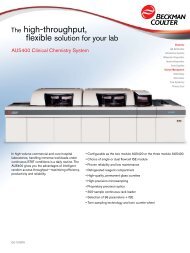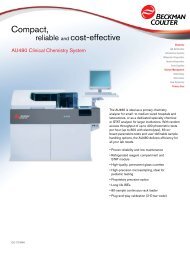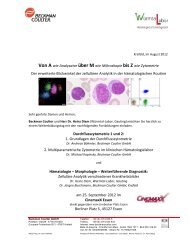p/ace™ mdq detectors - Beckman Coulter
p/ace™ mdq detectors - Beckman Coulter
p/ace™ mdq detectors - Beckman Coulter
- No tags were found...
Create successful ePaper yourself
Turn your PDF publications into a flip-book with our unique Google optimized e-Paper software.
CE SUPPLIESC APILLARIESAll methods development in CE begins with the choice of the correctcapillary surface. The goal is to choose a surface which will not interactwith the sample and, depending upon the application, one which willeither reduce or induce electroosmotic flow. <strong>Beckman</strong> <strong>Coulter</strong> offers achoice of several types of capillaries, which range in surface chemistryallowing a variety of samples to be analyzed including pharmaceuticals,industrial chemicals, chiral drugs, nucleic acids, amino acids, proteinsand peptides. These capillaries are available in defined lengths, whichmay be trimmed to optimize instrument type, speed and resolution.N EUTRALS URFACESNeutral surfaces are designed to coat the exposed silanol groups on the fused silica and serve two major functions: 1) to reduceelectroosmotic flow, and 2) to prevent wall interaction with the sample. However, not all neutral surfaces are the same and it isimportant to understand what the surface is composed of to ensure that other interactions (i.e., hydrophobic) do not replace theionic interactions you are trying to reduce. For example, when using a neutral capillary with a surface consisting of a hydrophobicbonded phase, it is essential to include hydrophilic polymers in the buffer to prevent hydrophobic interactions. The following isa list of neutral surfaces that are available from <strong>Beckman</strong> <strong>Coulter</strong>. All of these surfaces are bi-layers, consisting first of a bondedphase to shield the silanol groups followed by a hydrophilic polymer to prevent hydrophobic interaction.PART NUMBERDESCRIPTION477441 eCAP Neutral Capillary, 50 µm I.D.,45 cm total length, 12 cm from window to outlet(quantity 1)The neutral capillary utilizes a secondary layer of polyacrylamideto generate a hydrophilic surface. This is a general purpose capillary,which <strong>Beckman</strong> <strong>Coulter</strong> recommends as a starting point for handlingcomplex samples like proteins or basic molecules. Polyacrylamidesurfaces are recommended for use with both UV and LIF detectionsystems but may show some reduction in capillary life with diodearraydetection systems.477601 eCAP N-CHO Capillary, 50 µm I.D.,65 cm total length, 12 cm from window to outlet(quantity 1)The N-CHO capillary utilizes a secondary layer composed of polyvinylalcohol (PVA). This surface is ideal for the separation of complex sampleslike proteins or basic pharmaceuticals in cases where minimal EOFis desired. PVA is a very rugged surface, which is stable with UV, LIFand diode array detection systems. However, due to the chemical natureof PVA, it is not recommended for use with borate buffer systems, asthe borate ion will complex with the surface. This capillary has beenfeatured in the Carbohydrate Labeling and Analysis Kit (P/N 477600).<strong>Beckman</strong> <strong>Coulter</strong>ContentsIndex15


